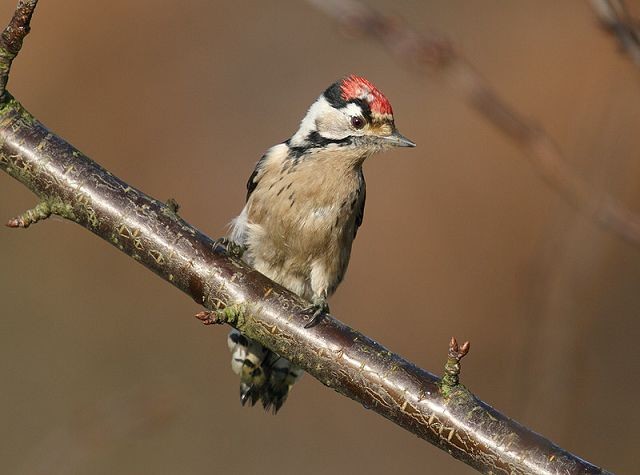
Lesser Spotted Woodpecker: Elusive at the best of times, spring sees them at their most 'conspicuous' (photo: Jon Hall).
March can be an interesting month, especially for patch-watchers and students of migration. Many resident birds are already getting on with breeding, so it can be a good time to be out and about doing nocturnal survey work to see if Long-eared Owls are in that plantation near you; or, much easier, to locate your local Tawny Owls. Some species, such as Crossbills, will already be nesting, and it can be a good time to be out looking for displaying Goshawks. Other resident species are also busy establishing their territories, and it is a good time to see normally elusive species such as Lesser Spotted Woodpeckers, who are at their most conspicuous (if that term can ever be applied to this diminutive woodpecker!) We also witness the withdrawal of many of our winter visitors, most of whom slip away unnoticed, unlike their arrival in the autumn months.

Sand Martin: Inland patch-watchers are always on the look out for the first of the year (photo: John Robinson).

Wheatear: Traditionally one of our first migrants (photo: Sue Tranter).
The mercurial spring weather can deceive both birds and birders! A mild southerly airflow not only increases the temperatures, but also encourages the rapid arrival of early migrants such as Sand Martins, Wheatears and Chiffchaffs. It can also tempt wintering birds of the latter species to burst into song - handy of you've got a wintering Siberian Chiffchaff that you didn't know about! In contrast though, a cold northerly can soon bring winter back into focus and curtail any immigration into the country overnight, so pay heed to the forecasts and pick your moment.
Other typically early migrants that are arriving by mid-month, assuming mild weather is the order of the day, include Sandwich Tern, Little Ringed Plover, Garganey, Ring Ouzel and Wheatear. It can be a good time to see the mix of winter and summer visitors side-by-side, be it Sand Martins over a lake of wintering wildfowl, or the 'shak-shak' of Fieldfares over a singing Chiffchaff.

Firecrest: Multiple arrivals at coastal watchpoints can be a feature of March (photo: Sean Gray).

Hoopoe: Often one of the first scarce migrants, especially off the back of a warm southerly airflow (photo: Chris Cook).
Scarcer species to be on the look out for at coastal watchpoints include Firecrest and Black Redstart. Even rarer overshoots can include Hoopoes and Alpine Swifts, whilst a number of show-stoppers over recent years have included the Scops Owl in Cornwall in 2002 and Little Crake in Kent in 1997. It is also a good month for Gyr Falcon, a long-staying, and obliging, bird being long overdue. Several Pine Buntings have been found during March in the past, so now is a good time to get out and grill your local bunting flock, if you are fortunate enough to have one.

Alpine Swift: Any early swift species deserves scrutiny, but the earliest often turn out to be Alpine! (photo: John Miller).
At this time of year gull roosts are always worth paying attention to. The volume of commoner birds moving through is high, and there is always a chance of a scarcer species dropping in, such as a Ring-billed Gull or perhaps one of the rarer species. Likewise local wildfowl are always worth looking through, perhaps there is an American Wigeon amongst your local Wigeon flock, a Green-winged Teal with the Teal or a Lesser Scaup with your diving ducks - all are regularly found during this early spring period.

Pine Bunting: A number of records have been found consorting with bunting flocks at this time of year (photo: Dave Hawkins).

Gyr Falcon: March is one of the best months for records of this dazzling raptor - getting one to hang around long enough to be enjoyed by the masses is something else (photo: Allister Irvine).

